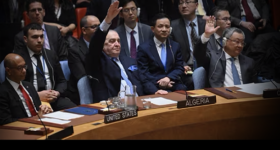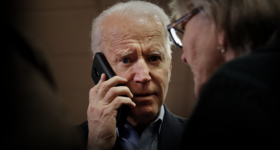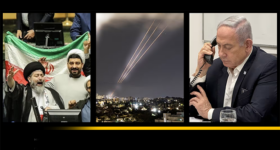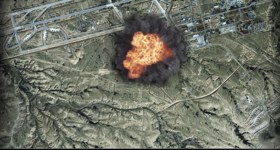
Moaz Moustafa (on right) facilitates John McCain’s illegal entry into Syria to meet with extremist group leaders and known kidnappers. (Photo: Antiwar)
The photos brought to public attention in January 2014 by the anonymous witness codenamed ‘Caesar’ show corpses, thousands in number, deceased from violent causes, some bearing signs of torture and many having suffered starvation and neglect.[1] The dead are said to be victims of Syrian state detention facilities, but it is now known that many were not, and it is still not known for sure how many of them were.[2]
If the atrocity of the crimes to which the photos attest is in no doubt, the question of who perpetrated them is less clear-cut. Yet Western reports have unequivocally blamed the ‘Assad regime’. A counter-hypothesis, hardly considered in public discussions, is that many of the bodies were of civilians captured by Jaish al-Islam (JAI) after taking control of Douma in December 2012. JAI are known to have starved their captives while using them as slave labourers, which they did on a scale monumental enough to create the extraordinary network of deep and impressively engineered tunnels that we now see had been built across the area under their control.[3]
Nevertheless, a Qatari-sponsored prosecution team vouched for the Caesar evidence as being ‘capable of being believed’ – in a court of law – to show ‘systematic torture and killing of detained persons by the agents of the Syrian government.’[4] The Western media’s subsequent dissemination of the prosecutors’ interpretation of the images – unchallenged – caused it to be widely believed in the ‘court of public opinion’. Despite significant unsettled and unsettling questions, then, a particular account of what the images show has exercised considerable influence over people’s default assumptions about accountability for atrocities in Syria.
It is the influence of this specific interpretation of evidence that will be reflected on here, and without prejudice as to what may be established about occurrences in Syrian detention on other bases.[5] Questions about the Caesar evidence point up concerns about the extent to which the dissemination of inaccurate information might have distorted the written historical record of our times and how it may have practically influenced real decisions and events.
It matters to get at the truth about the photos for those reasons, as well as for the sake of families whose loved ones have disappeared, but there is also a further reason. This concerns a use made of Caesar’s testimony that may affect the future course of history too. It is the promotion by Western prosecutors of judicial innovation in the pursuit of accountability for atrocity crimes. The purpose of this article is to set out how and why that is a concern, and fundamentally one about justice.
To situate the discussion it will be worth briefly outlining the contrasting kinds of reception the Caesar testimony has received – affirmative versus sceptical – and then also pointing to a much less noticed reception, one of significant silence. For there is an identifiable group of usually vocal critics of the Syrian president and government that has refrained from mentioning the name Caesar. This in itself could be somewhat revealing about what intelligence that group accepts as authoritative. But it also throws into relief the distinctive commitments of another group who, by contrast, have made considerable use of the Caesar name.
It is they who have, for instance, provided the impetus behind successful lobbying for the Caesar Syria Civilian Protection Act in the United States. Less spectacular, but of potentially more enduring international significance, is dissemination of Caesar’s narrative in a wider campaign aimed at creating increasingly flexible mechanisms for international criminal prosecutions.[6]
Billed by some as a progressive and cosmopolitan approach to ‘global justice’ that sets human rights above the prerogative of despots, this movement might more cautiously be assessed as legitimising ‘regime change’ by means of judicial innovation. Such use of the Caesar testimony could serve not only to delegitimise the current president of Syria but also to enhance the possibility of delegitimising any head of state.
This would be at the initiative of prosecution teams who themselves are accountable to their clients and sponsors rather than to the victims of conflict or to principles of humanitarian justice. The argument thus to be developed in this article commends caution about both the evidentiary value of the Caesar testimony and the intentions of those who have most vocally asserted it.
Caesar, his story and the questions raised.
The basic outline of Caesar’s story can be sketched quite succinctly. According to the testimony attributed to Caesar, he had been working as a military photographer in Damascus, where his job was to photograph the dead for purposes of state record keeping. In 2011, concerned at the number of deceased, and the visible indications of torture and starvation, he started smuggling digital files of the images to a contact, now referred to as Sami, who passed them to the Syrian National Movement (SNM). In August 2013, the SNM facilitated Caesar’s extrication from Syria, to be followed shortly after by his immediate family members.
The SNM, although based in Turkey, was backed by Qatar, and the Qatari government hired a team of lawyers and forensic specialists to assess the credibility of the witness and his evidence as a basis for potential prosecutions. In a matter of days the team pronounced Caesar’s evidence ‘capable of being believed’ in a court.[7]
Caesar was then taken to Washington on a visit facilitated by Mouaz Moustafa, director of the Syrian Emergency Task Force, a US State Department sponsored organisation representing some of the anti-government forces in Syria. When giving testimony there, Caesar’s face was concealed and his words were whispered to Moustafa, who acted as translator. After appearing in several other high profile venues with similar arrangements for anonymity, Caesar withdrew from the limelight.
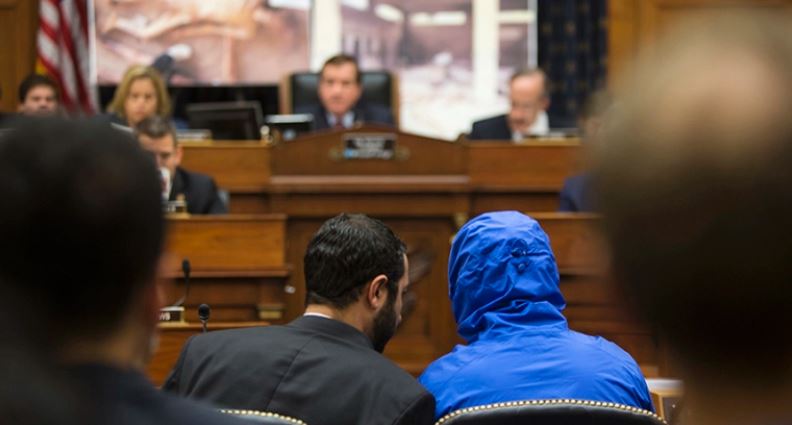
Caesar testimony fed through Moaz Moustafa, facilitator of McCain’s trip to meet “rebels” in Syria. (Photo: Tim Hayward blog)
Meanwhile, an influential section of United States political opinion has pronounced itself confident enough in the witness Caesar to enact legislation in his name – the Caesar Syria Civilian Protection Act – aimed at enforcing ‘accountability’ measures on Syria. The lead author of the Caesar Report, David Crane, has spoken of the photographic evidence as a ‘smoking gun’, words echoed by Keith Harper, US Ambassador to the UN Human Rights Commission (UNHRC). Stephen Rapp, the former US Ambassador At Large for War Crimes, has stated that the photos help to provide ‘much better evidence than has been available to prosecutors anywhere since Nuremberg’.[8]
Prosecution teams in Europe have also attributed great value to the photos as evidence of atrocity crimes.[9] Among the lawyers prominent in promoting the prosecutorial value of the Caesar evidence are Toby Cadman,[10] Wolfgang Kaleck[11] and Patrick Kroker.[12] Meanwhile, the NGO Human Rights Watch produced its own report claiming to validate some of the Caesar evidence.[13] A number of journalists have also expressed themselves convinced, including Richard Engel, who has met ‘Caesar’, and Josh Rogin, Ben Taub, Susie Linfield,[14] Nick Robins-Early,[15] Adam Ciralsky,[16] Jim Muir for the BBC,[17] as well as many more contributors to news outlets including Spiegel,[18] Daily Mail,[19] CNN.[20]
Garance le Caisne wrote a book on Operation Caesar, and documentary films featuring it include Sara Afshar’s Syria’s Disappeared. Affirmation of the evidence has made its way into academic publications too. Some of this has come from people involved in organisations campaigning for an approach to justice and accountability for atrocity crimes that allows implementation of a ‘responsibility to prosecute’.
Those with this interest include prosecution lawyers and advisors like Stephen Rapp, David Crane, Wolfgang Kaleck, Patrick Kroker, and Beth Van Schaack. Other academics who have cited the Caesar evidence uncritically, treating it as part of an established factual record, include: Noha Aboueldahab;[21] Jamie Allinson;[22] Adam Bazco, Gilles Dorronsoro and Arthur Quesnay;[23] Nader Hashemi;[24] Bessma Momani and Tanzeel Hazak;[25] Chris Tenove;[26] and Thomas Weiss.[27]
Some academics have cited the HRW report rather than the original Caesar Report, even if, like Van Schaack,[28] they apparently did not notice how HRW had significantly modified some of the original report’s claims, such as the 11,000 victims figure that HRW corrected down. In all, it can certainly be said that Operation Caesar has made its way into publications that will be regarded as laying down the historical record.
Not everyone is convinced, however. Even the initial reception was cautious in some quarters. One reason was the revelation that Operation Caesar had been initiated by Qatar, a country that had been providing funds – now known to be in the billions of dollars – to opposition fighters aiming to bring down the government of Bashar al-Assad.
There were also the questions, flagged at the start of this article, that are simply begged by appeals – of Rapp and others – to the confirmation by the FBI that the photos showed real dead people.[29] Other serious concerns have been set out in detail by Rick Sterling[30] and Adam Larson[31], but an elementary and conspicuous one is the unconvincing justification for Caesar’s anonymity, which serves to prevent any rigorous independent questioning of his story.
The rationale given for secrecy appears to depend on the implausible proposition that a photographer in the state’s employ could go missing and yet not be missed. A result of the anonymity is that the public ultimately has to place a lot of trust in the competence, integrity and good faith of the people translating and relaying the story. Given that these are people pressing a case for the prosecution, it would be only proper to allow a full examination of the methods they have deployed in presenting their case.
From a defence perspective, it would be hard to ignore facts like prime mover Rapp and the fixer and translator Moustafa having been among the most persistent lobbyists on Capitol Hill for regime change – previously in Libya and then in Syria. Rapp, furthermore, has been campaigning for changes in international criminal law that would lower the barriers to prosecution for atrocity crimes. Even their allies in the quest to prosecute Assad have expressed reservations.
Notably, the directors of the organisations gathering the documentary evidence that Rapp finds the necessary complement of Caesar’s evidence have been quite clear on the point. Thus Bill Wiley, director of the Europe-based Commission for International Justice and Accountability (CIJA) has said ‘would it make a case against Assad? No, not at all, not at all.’[32] Wiley’s counterpart in America, Mohammad al-Abdallah – director of the Syria Justice and Accountability Centre – is also deeply sceptical of the photos’ evidentiary value.[33]
Who dares to cite Caesar?
The central concern of this study can now be further delineated by reference to a group of social media commentators who, to my initial surprise, have appeared to accept that point. This is a group of people who are generally vocal in matters relating to the war in Syria and would not typically pass up an opportunity to highlight crimes alleged of the Syrian president and government.
This group would include Idrees Ahmad, Eliot Higgins, Oz Katerji, Scott Lucas, George Monbiot,[34] Thomas Pierret and Robin Yassin-Kassab. None of them – as far as I can discern – has ever referred to Caesar.[35] The most natural explanation would be that each has individually examined the Caesar Report and decided it did indeed give rise to the critical concerns that sceptics have identified.
However, the same people have been prepared to refer to the HRW report that validates the Caesar evidence, even though it does not address the critical questions. It is as if they are aware that particulars of the Caesar story may be vulnerable to being discredited but they are satisfied that the reputation of the NGO makes it safe to cite as an authority.
What makes this anomalous is that similar caution does not come into play for members of the group with regard to other operations that are no less controversial. A notable example would be the White Helmets. The idea that the White Helmets organisation consists of unarmed humanitarian volunteers devoted to altruistic and impartial service of their home communities is demonstrably misleading in that the funding, coordination and training comes from abroad, its recruits are paid, and they do not represent or serve all sections of Syrian society.
If some of the men may simply be carrying out the tasks they are ostensibly paid to, others have appeared to bear arms and to collaborate with militant extremists. Some have been accused of crimes, including serious ones, and there are even questions about whether some may have been involved in committing atrocities. In short, if one sees reason to be cautious about the credibility of Caesar it would be consistent and reasonable to be cautious about the White Helmets too.
In order to try and resolve the anomaly, it is worth considering another feature of the White Helmets operation that invites comparison with the Caesar narrative:
‘Like Caesar, the White Helmets—also known as the Syrian Civil Defense forces—have become inadvertent documentarians. … White Helmet volunteers have testified before the Security Council, in capitals, and elsewhere and provided photographs and videos of the aftermath of attacks that have helped to shed light on chemical weapon use.’[36]
This documentary role – ‘inadvertent’ or otherwise – has not been lost on promoters of the two operations. Of the Caesar exhibition, Van Schaack observes ‘Such displays respond to the behavioral psychology research on the “picture superiority effect,” which teaches that humans respond to photos more viscerally than to text.’
Of the White Helmets, James Le Mesurier has explained how, in 2012, the security firm he then co-directed, ARK FZC, consulted global market research showing that military and security actors were least likely to win public trust whereas first responders are the most trusted.[37] Thereupon ARK created the White Helmets, and Le Mesurier subsequently formed the Netherlands-registered non-profit Mayday Rescue to manage them (although he was funded from sources like the UK FCO through his company Mayday Rescue FZ-LLC based in a UAE tax haven). As documentarians, the White Helmets have had a much more widespread and sustained impact than Operation Caesar.
So there are some differences worth reflecting on. First, the publicity value of the Caesar images needs no narrative or naming, no due process or due diligence to underwrite, since it is immediate and visceral.
The name that needs to be tagged to those images, moreover, is not Caesar but Assad.[38] People don’t need to be kept in mind of the codename for an operation but they do need to have in mind a constant association of those terrible images with the name of Assad. Seen in this light, therefore, silence about Caesar is an entirely consistent element of an anti-Assadist strategy to influence public opinion.
By contrast, although the White Helmets also make considerable use of imagery,[39] their narrative and their projected identity are necessary for situating and making sense of the images. Moreover, they are protagonists of their own narrative and have remained in situ to cover continuing developments on the ground (even if they have had to move towns as battle lines have shifted).
Their trustworthiness being necessary for the effect of their message, it has been vigorously defended even in the face of serious criticisms. So it is not so surprising, after all, that activists and publicists who have avoided getting drawn into discussion of the Caesar narrative stand firm in defence of the White Helmets narrative.
But if the preference for the White Helmets over Caesar is explicable in those terms, what then needs to be understood is why some other people have nevertheless so actively promoted the Caesar narrative. If the initial purpose of promoting it was to press President Obama’s administration to take a more active interventionist approach to Syria, then it had already failed, and Caesar was not in a position to produce any new evidence. In seeking an explanation it is worth reflecting on who has been most active and consistent in promoting Operation Caesar – from its inception to this day.
The Caesar promoters
The lead author of the Qatari-commissioned Caesar report is David Crane, and he also leads the Syrian Accountability Project (SAP), which he founded some time prior to Caesar’s defection.[40] SAP is said to be student-run and its clients include the Syrian National Council and US State Department.[41] It also ‘works very closely with’ the Syria Justice and Accountability Centre, which in turn is a conduit of US funding to CIJA.
Incidentally, Rapp, Crane, and fellow Caesar Report author Desmond De Silva, were all previously successive holders of the same job, namely, chief prosecutor at the Special Court for Sierra Leone.[42] The man who brought Caesar from his Qatari handlers to the West, and accompanied him on tour, even providing his voice, is Mouaz Moustafa.
Moustafa’s constant companion on the tour – which has included visits to the UK Foreign Office – is Rapp. Rapp was also involved in founding the organisation supplying the documentary evidence that is a sine qua non for the legal effect of Caesar materials. Now known as CIJA, that organisation grew out of Wiley’s collaboration at ARK FZC with the UK FCO’s go-to contractor, the former diplomat Alistair Harris, who through his ARK business also founded the White Helmets and other Syria security and ‘stabilisation’ projects.
Harris, a man of ideas and advocacy as well as action, was co-author with Cadman and Moustafa of a 2013 paper for RUSI urging that it was not too soon to start implementing transitional justice in Syria; and Harris’s ARK has been a conduit of funding – received from US as well as UK – for Moustafa’s organization SETF. As for the European prosecutions, and related initiatives pressing for ‘universal jurisdiction,’ Rapp is there too a constant and inspirational presence.
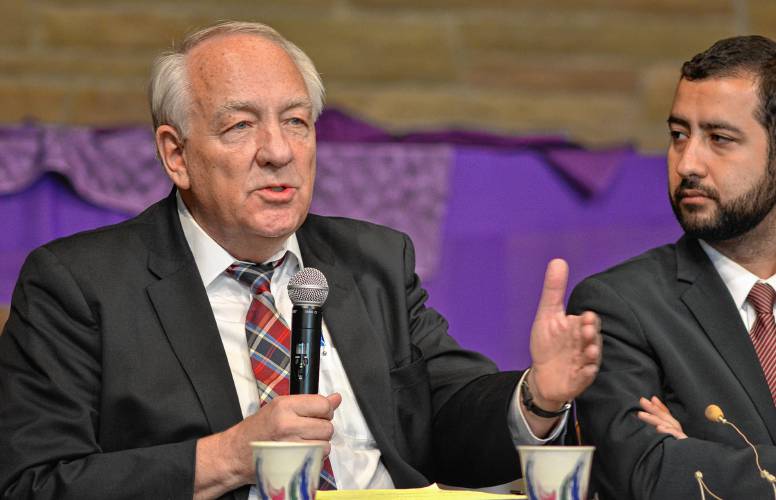
Stephen Rapp with Moaz Moustafa in New Hampshire. (Photo: New Hampshire Gazette)
Rapp’s core ambition is not focused exclusively on President Assad. He advocates in more general terms a principle of ‘no peace without justice’, which he interprets as implying a ‘responsibility to prosecute’ whose ultimate implications would be to enhance the legitimacy of externally imposed regime change operations on any nation – not just Syria – whose leadership is deemed to be oppressing its people and standing in the way of democracy and freedom.
It may be noted that Rapp has been part of on-going high level US deliberations about how to finesse that nation’s awkward situation of wanting to see other countries’ leaders prosecuted while not itself even signing up to the existing procedures that are provided by the International Criminal Court (ICC).
This conundrum has exercised the American elite for some years, and Rapp appears committed to a solution that lies in promoting innovative jurisprudence and hybrid courts. It would be facilitated by the emergence of a principle of ‘universal jurisdiction’, a principle that has gained particular traction in Germany, and some in other European countries too, like Spain, France and Sweden,[43] where the Caesar materials have apparently been deployed in courts.
In short, there is a discernible aim here of redefining the rules of the ‘rules-based international order’, with particular relevance to who shall be permitted to govern a country.[44] This is to press for global rules that override the powers of nation-states – a development whose effects are akin to what is already being accomplished through trade and investment agreements like TTP and TTIP by imposing rules of corporate globalism on nations with compliant governments.
Thus, from the standpoint of concern to serve US-based corporate interests, there is more at stake than the matter of who should be president of Syria.
The purpose of Caesar
Viewed from that perspective, Operation Caesar appears as a particular expedient in relation to a particular recalcitrant nation-state. The Caesar materials are likely to have little or no direct legal effect to that end, however, according to Wiley, and will not make a case against Assad in courts.
What the images do is harness powerful human emotion to the case. And it is entirely fitting that great human emotion should be stirred by images of human atrocities, as it may also be fitting that justice and accountability should be sought. If war crimes are committed, justice arguably requires accountability for them,[45] and so the value of evidence has to be assessed on its merits, and that means creating opportunities for such an assessment – even, conceivably, by deploying innovative judicial means.
I would just add that there are also other important considerations to keep in mind.
First, justice has to be assiduously sought by means that are rigorously directed to the pursuit of truth. This would be a sine qua non for just retribution. The pursuit of justice requires great scrupulousness of method and honesty of intent; it entails respecting the presumption of innocence, ensuring procedures are impartial and consistent, with due transparency and openness. These are qualities that need ensuring and cannot be assumed to follow from initiatives of ‘innovation’ that are pursued by special interest groups as is a concern about Operation Caesar.
Second is the need in due process to reserve judgement as to the honesty and intentions of witnesses to any alleged crime, pending their evidence being put to the test in a properly constituted hearing.
For the purposes of justice it is never to be assumed that all people at all times act honestly and in good faith, for it is precisely because they do not that institutions of justice are required to provide a remedy.
Thus a requisite degree of realism in retributive justice has always to attend to motivations, including thoughts about deterrents and incentives. As well as this general concern there is in the present context also a more specific kind of concern. It is a fact that deceptive events are sometimes staged, including by way of what are referred to as false flag operations.
Regarding many of the various accusations of atrocity crimes levelled against the Syrian government there are reasonable grounds for doubt, and justice certainly requires that no blanket presumption be made about the dependability of testimony from witnesses like the White Helmets or Caesar.
Third, although the Caesar evidence, like that of the White Helmets, has never been tested in a properly constituted court of law, it has sounded very loudly in the media and has thus exercised a determinate influence on the ‘court of public opinion’.
The media reports that shape public opinion, however, often appear to have scant regard for truth or accuracy, let alone justice. Insofar as promoters of prosecutions against state leaders are also seeking to use ‘innovative’ forms of justice effectively to lower the barrier to effective prosecutions, it could be perceived as extremely prejudicial that they are able to make their case so unrestrainedly to the wider public ahead of any properly constituted hearing.
Fourth, there is the distinct possibility that under circumstances where not only is public opinion manipulated but also political agendas are promoted, the communications can even provide incentives to stage harmful acts as false flag operations.
Specifically, the pronouncement of red lines can favour this effect. There are strong grounds for suspicion that in practice this effect has operated from time to time in Syria, as elsewhere, and a simple logic of incentives does nothing to assuage such suspicions.
It is therefore a matter of serious concern that the informal penumbra of ‘justice and accountability’ talk that goes to support the imposition of ‘red lines’ could be not only prejudicial to the trying of crimes that have occurred but potentially be used to support incentives for crimes to be committed.
The fifth point is the most important of all. Concerns about justice and accountability for war crimes are ultimately about acting on behalf of the moral conscience of humanity.
If any given war crime shocks the human conscience, then so much more ought the very occurrence of war itself do so, especially when it is not clearly just or necessary.
If war crimes have been committed in Syria it is because there has been a war in Syria – a war that need never have been but for the provocations and facilitations of external actors.
If we truly want to hold people responsible for war crimes, then should we not attribute great responsibility to those whose actions are among the root causes of them?
Let us bear in mind, for instance, that Qatar was the biggest supplier of funds and arms to the enemies of Syria’s government, and that the United States has been a major orchestrator of international collaboration to delegitimise that government. With such facts in mind, it can be argued that for agents of those states to be producing evidence to accuse Syria of war crimes is to add moral insult to injury.
Had these states not promoted an armed insurgency in the first place, there would have been no war and thus no war crimes in Syria. They certainly have earned no benefit of the doubt regarding the anonymous, secretive and unverifiable testimony their agents jointly presented in Operation Caesar.
On this last point, it is further interesting to note that we in the West do not receive much unfiltered communication from the side of the defence to these attempted prosecutions. We hear that Syria, Russia, China and various non-aligned countries have forceful reservations but this is always attributed to pure political calculation on their part. ‘They’, it seems, are always subject to conflicts of interest whereas ‘we’, in the West, are concerned only with the pure pursuit of humanitarian justice.
Just how far this might be from the truth is glimpsed in the reflections of former international criminal defence lawyer Christopher Black. His considerations of the modus operandi of prominent prosecutors like those pressing the ‘responsibility to prosecute’ as part of an ‘innovative justice’ agenda are sobering, to put it mildly.[46] For present purposes, however, it suffices to have indicated the much bigger game that the Caesar testimony has played a small part in.[47]
In conclusion, I would emphasise that it behoves us to try and be clear about the effects of Operation Caesar and learn lessons from the study of it. Having noted that even vocal critics of Assad and his government avoid appeals to Caesar, and given the serious criticisms made by others, we have good reason to reserve judgement as to its credibility.
This means that those who have committed to accrediting it as wholly true have quite possibly disseminated a falsehood. With NGOs, journalists and even academics embedding in it lessons of that possible falsehood, the historical record may already have been distorted in ways that may not be undone. But a still greater concern is that further harms may be generated in the future not only as a result of misinformation but also as a result specifically of what the West’s legal innovators are seeking, which is nothing less than a change in the rules of the ‘rules-based international order’.
We already find some scholars of international law viewing such changes as positive steps towards ‘global justice’. This is a matter about which more critical concern should be in evidence than has been to date.
To put bluntly this contextualised concern about Operation Caesar: not only may it already have altered the historical record, and not only may its effects have served to alter somewhat the course of history to date, but in serving to influence decision makers, it may contribute more indelibly to shifting the baseline of normative consensus in a direction favourable to ousting non-compliant leaders of sovereign states.
That is effectively to bestow legitimacy on imperialist regime change projects.
What justice meanwhile requires with regard to the ‘Caesar’ evidence is genuine and impartial investigation into the truth about who died and at whose hands. The instrumentalisation of those terrible deaths for the purposes of further destabilizing a country ripped apart by violent forces that are aided and abetted by foreign states – including so-called liberal democracies – is itself an affront to the conscience of humankind.
***
[1] For an overview of the story at the time see Ian Black in The Guardian https://www.theguardian.com/world/2014/jan/20/evidence-industrial-scale-killing-syria-war-crimes. For a later and fuller reconstruction see Adam Ciralsky in Vanity Fair: https://www.vanityfair.com/news/2015/06/assad-war-crimes-syria-torture-caesar-hospital.
[2] See the Human Rights Watch study of the Caesar evidence: https://www.hrw.org/report/2015/12/16/if-dead-could-speak/mass-deaths-and-torture-syrias-detention-facilities. For a more detailed and critical study of the evidence see the website of Adam Larson: http://libyancivilwar.blogspot.com/search?q=caesar.
Drawing on Larson’s study, Paul McKeigue has summarised what is not in dispute and what other factors should be borne in mind (personal communication) and I follow his advice in the summary that follows.
Not disputed:- The photos show the bodies of at least 5000 adult men at the Damascus military hospital, many of whom have been starved, over a period of about 8 months up to August 2013. Their identities are unknown, and the bodies have been labelled with numbers.
Other factors:- Some of them may be battlefield casualties, although most have no obvious external injuries. Some of them appear to have been gassed while hung upside down. From this, and the signs of prolonged starvation it is clear that most of them were captives. What is not known for certain regarding most of them is whether they were captured and/or killed by the government or by rebel forces (since the fact of being gathered for delivery to the mortuary could apply in either event. Some victims have tattoos indicating they are Christian, Shia or Assad supporters. The picture is further complicated by the fact that there were prisoner swaps between the Syrian Arab Army (SAA) and JAI in 2013.
Adam Larson (personal communication) adds that there is no semblance of a prison uniform evident in the photos, the men being mainly naked or in underwear, in street clothes or, in a few cases, still in their camouflage military uniforms.
For my part, I do not have the knowledge or expertise to offer an opinion as to the relative likelihoods of the two hypotheses. Nor does my argument depend on the likelihood of the JAI hypothesis being much greater than the official Western hypothesis, as Larson and McKeigue suggest it is. (Nor can some combination of those or other possibilities be definitively ruled out.) My argument relies only on the consideration that a self-consistent and materially possible explanation has not been ruled out while the accepted Western narrative has not been sufficiently established.
[3] https://www.youtube.com/watch?v=PgGqwAwJL5M&feature=youtu.be
[4] https://www.carter-ruck.com/images/uploads/documents/Syria_Report-January_2014.pdf
[5] This is a point made particularly effectively by Dan Murphy in an early response to the Caesar evidence: for he declares himself convinced on the basis of reports from other sources that the Syrian security apparatus is in fact responsible for large scale and egregious violation of human rights, and yet he vigorously challenges the credibility of the Caesar Report. https://www.csmonitor.com/World/Security-Watch/Backchannels/2014/0121/Syria-smoking-gun-report-warrants-a-careful-read
[6] These include, most recently, creation of the International Impartial and Independent Mechanism (IIIM).
[7] https://www.carter-ruck.com/images/uploads/documents/Syria_Report-January_2014.pdf
[8] Rapp in a 2016 interview with Ben Taub in the The New Yorker: https://www.newyorker.com/magazine/2016/04/18/bashar-al-assads-war-crimes-exposed
[9] These include ECCHR https://www.ecchr.eu/en/case/caesar-photos-document-systematic-torture/ and the Guernica teams https://www.guernicagroup.org/syria, and German Public Prosecutors in Karlsruhe https://en.qantara.de/content/assads-crimes-tried-in-german-courts-hoping-for-justice.
[10] Before setting up the Guernica teams, Cadman had been an associate at Cherie Blair’s law firm Omnia and was at the centre of a scandal: https://www.independent.co.uk/news/uk/politics/cherie-blairs-right-hand-man-previously-pitched-to-represent-the-other-side-in-maldives-case-a6779321.html. This is relevant to mention insofar as much of the drive for judicial innovation is based on arguments about humanitarianism and morality that sit uneasily alongside motivations of making business profits.
[11] Wolfgang Kaleck founded the European Center for Constitutional and Human Rights (ECCHR) together with other internationally renowned lawyers in Berlin in 2007. He has promoted prosecuting on the basis of Caesar evidence https://www.ecchr.eu/nc/en/press-release/torture-in-syria-investigations-in-austria-are-a-first-step-now-arrest-warrants-must-follow/
[12] Patrick Kroker is responsible for ECCHR’s work on Syria. He sets out his perspective in this interview: https://www.youtube.com/watch?v=qyi3jkDCRlE&feature=youtu.be
[13] https://www.hrw.org/report/2015/12/16/if-dead-could-speak/mass-deaths-and-torture-syrias-detention-facilities.
[14] Susie Linfield in The New York Review of Books: https://www.nybooks.com/daily/2019/02/09/syrias-torture-photos-witness-to-atrocity/)
[15] https://www.huffingtonpost.co.uk/2015/03/28/syria-war-crimes_n_6950660.html
[16] Adam Ciralsky in Vanity Fair: https://www.vanityfair.com/news/2015/06/assad-war-crimes-syria-torture-caesar-hospital.
[17] Jim Muir for the BBC: https://www.bbc.co.uk/news/world-middle-east-25822571
[18] http://www.spiegel.de/international/world/spiegel-reporting-supports-accounts-of-torture-and-execution-in-syria-a-945760.html
[19] https://www.dailymail.co.uk/news/article-2544711/Starved-tortured-throttled-The-true-horror-Assads-soldiers-execute-rebel-prisoners-revealed-new-images-released-today.html
[20] https://edition.cnn.com/2014/01/20/world/syria-torture-photos-amanpour/index.html t.
[21] Noha Aboueldahab, Writing Atrocities (2018)
[22] Jamie Allinson, ‘Disaster Islamism’ (http://salvage.zone/in-print/disaster-islamism/
[23] Adam Bazco, Gilles Dorronsoro and Arthur Quesnay Civil War in Syria, Cambridge UP 2017.
[24] Nader Hashemi, ‘The ISIS Crisis and the Broken Politics of the Middle East’ http://www.bu.edu/cura/files/2016/12/hashemi-paper1.pdf
[25] Bessma Momani and Tanzeel Hazak, ‘Syria’, in The Oxford Handbook of the Responsibility to Protect Edited by: Alex Bellamy, Tim Dunne 2016 Oxford University Press.
[26] Chris Tenove (2019), ‘Networking justice: digitally-enabled engagement in transitional justice by the Syrian diaspora, Ethnic and Racial Studies’, DOI: 10.1080/01419870.2019.1569702
[27] Thomas G. Weiss (2014) ‘Military Humanitarianism: Syria Hasn’t Killed It’, The Washington Quarterly, 37:1.
[28] Beth Van Schaack (2019) ‘Innovations in International Criminal Law Documentation Methodologies and Institutions’ https://papers.ssrn.com/sol3/papers.cfm?abstract_id=3329102
[29] Tim Anderson has commented that ‘we have no way of verifying in which year, circumstance or even which country the photos were taken. Those who finance and arm the sectarian groups have slaughtered hundreds of thousands in recent years, in the wars in Afghanistan, Iraq and Syria. There is no shortage of photos of dead bodies…’ (Tim Anderson ‘The Dirty War on Syria: Barrel Bombs, Partisan Sources and War Propaganda’ Global Research 7 October 2015). However, after a very close study of the photographs, Adam Larson believes that the photos were taken in the Damascus area and that the deaths occurred within that area, mostly in the period from mid-late 2012 to August 2013. This fact, nonetheless, does not make the Syrian government a more likely suspect for their murder than Jaish al-Islam. (Adam Larson, personal communication)
[30] Rick Sterling, ‘The Caesar Photo Fraud that Undermined Syrian Negotiations’ https://dissidentvoice.org/2016/03/the-caesar-photo-fraud-that-undermined-syrian-negotiations/
[31] Adam Larson, ‘Fail Caesar’, in 10 parts: http://libyancivilwar.blogspot.com/search?q=caesar
[32] Wiley interviewed in the Al Jazeera documentary Syria: Witnesses for the Prosecution https://www.youtube.com/watch?v=9GGK4zrl7P0 ). Speaking at a conference organised by his friend David Crane at Syracuse University, Wiley is clear that for advocacy groups like Amnesty and HRW ‘the burden of proof for the sort of evidence they need for their reports, it is very, very low. … Oftentimes they do allege crimes, in my opinion, incorrectly, but they are just drawing attention to the suffering.’ (19.55) (https://www.youtube.com/watch?v=enJvVvN8thU (Running for Cover conference, Syracuse, 2016)
[33] Mohammad al-Abdallah quoted in Enab Baladi’s Investigation Team (2018) ‘Al-Assad’s crimes in millions of documents: When will accountability start?’ https://english.enabbaladi.net/archives/2018/10/al-assads-crimes-in-millions-of-documents-when-will-accountability-start/
[34] For readers not familiar with these debates, but who know Monbiot for his interesting work on environmental issues, his inclusion in this list may be surprising. I for one was very surprised to discover the company he keeps in this matter, and after some rather disagreeable interactions with him on the subject, I did an extended study attempting to understand it: https://timhayward.wordpress.com/2018/04/11/how-we-were-misled-about-syria-george-monbiot-of-the-guardian/
[35] I stand to be corrected on this, of course, and I do note that Caesar has been referred to by Higgins, for instance, in the context of geolocating one of the photos, but without direct comment as to its significance.
[36] Beth Van Schaack (2019) ‘Innovations in International Criminal Law Documentation Methodologies and Institutions’, p.40.
[37] This information comes from an address delivered by Le Mesurier at The Performance Theatre in 2015 [links to the video recording of which appear to have been taken down].
[38] See the discussion in Lissa Johnson, ‘The Psychology of Getting Julian Assange’ Pt 5 https://newmatilda.com/2019/03/25/the-psychology-of-getting-julian-assange-part-5-war-propaganda-101/.
[39] As shown by Simone Rudolphi (2018), ‘Analysis of White Helmets’ Visual Strategy’, Masters Thesis, University of Sunderland.
[40] Already in 2013, before Caesar’s defection, Crane was ‘working with a team of lawyers and civil-society advocates to set up an archive of war crimes and atrocities committed in Syria that could be used as a basis for prosecution.’ As Crane put it, “We former chief prosecutors are like racehorses – you can put us out to pasture but we still want to run.” (https://www.newsweek.com/2013/09/27/david-cranes-prosecution-former-liberian-president-charles-taylor-238008.html)
[41] http://www.iamsyria.org/uploads/1/3/0/2/13025755/syria-sap_general_overview.pdf
[42] http://www.rscsl.org/prosecution.html
[43] Thierry Cruvellier (2019) ‘European Justice Strikes on Crimes in Syria’ https://www.justiceinfo.net/en/tribunals/national-tribunals/40383-european-justice-strikes-on-crimes-in-syria.html
[44] Ultimately, however, what is at stake affects the United States as a nation of people too, since what is driving it is a form of association that knows no national loyalties to any body politic but only to the interests of those with control of the world’s mega-corporations.
[45] I say ‘arguably’, since another view would take justice to have a more complex relationship with peace such as may find some place for the principle of amnesty – forgetting – but the present paper does not call into question the principle of punishing war crimes through due process.
[46] See Christopher Black (2014), ‘Rwanda and the Criminalisation of International Justice: Anatomy of War Crimes Trials’, Global Researchhttps://www.globalresearch.ca/rwanda-and-the-criminalisation-of-international-justice-anatomy-of-war-crimes-trials/5408604 and ‘Rwanda Confronting the 1994 Apocalypse’ https://christopher-black.com/rwanda-confronting-the-1994-apocalypse/
[47] See also the perspective offered by the historian John Laughland on the notion of International Justice, as in this video interview: https://www.youtube.com/watch?v=q4_J-ZxYnMw
READ MORE WHITE HELMETS NEWS AT: 21st Century Wire White Helmets Files
READ MORE SYRIA NEWS AT: 21st Century Wire Syria Files
SUPPORT 21WIRE – SUBSCRIBE & BECOME A MEMBER @21WIRE.TV





